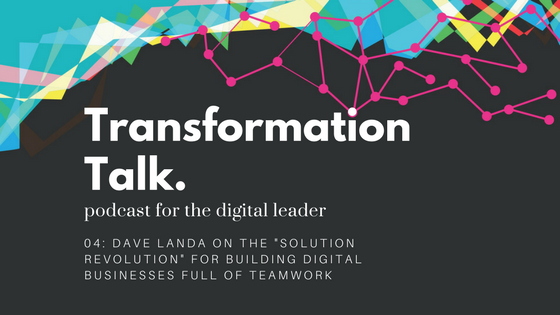This week, we're speaking to Dave Landa, CEO of Kintone and champion of cloud computing and digital transformation.
 As the CEO of Kintone, Dave runs the US operations of parent company Cybozu, and has helped Kintone, a leading build-your-own application and collaboration software service, achieve triple-digit growth last year alone.
As the CEO of Kintone, Dave runs the US operations of parent company Cybozu, and has helped Kintone, a leading build-your-own application and collaboration software service, achieve triple-digit growth last year alone.
Kintone has helped more than 7,500 customers worldwide enhance their businesses. On the Kintone platform, customers have built more than 350,000 custom applications, and that number continues to grow. In addition to his work at Kintone, Dave also sits on the board of the fitness and health organization, PHIT America, which encourages Americans to take control of their personal health through fitness.
Today, Dave joins us to talk about digital transformation and how Kintone is making it easier than ever for businesses to create and deploy software that meets their specialized needs.
Where did Kintone start, and what’s its current mission?
Kintone started with our parent company, Cybozu, in Japan. Their mission started to make teamwork better globally. And overall, the corporate mission remains the same.
Kintone has that same mission, but broadens it to include more individuals. We're talking about the solutions revolution, where citizen developers are empowered to change their business environment to a more productive, happier environment.
Kintone was recently recognized on the Gartner Magic Quadrant for high-productivity application platform as a service. What does that mean, and why is it important for business?
High-productivity means enabling business users to build applications. It’s abstracting code to enable lots of different components of a business solution to be configured easily by business users. High productivity is in contrast to high control, which is for developers to be able to manage with more complex developer interfaces. High productivity is really focused on the business user, enabling them to build solutions to meet their custom business needs quickly, very agilely.
UNLEASH YOUR INNER HERO: Kintone Connect Digital Workplace Conference in San Francisco
What are the biggest myths about low-code or no-code platforms?
The idea of no-code or low-code development traditionally says that you can't make complex, sophisticated applications. But these types of solutions, at Kintone in particular, have evolved and developed to a point where we are empowering extremely complex solutions, large teams and complex processes. Probably the biggest myth is the idea that you can only make basic applications, but that's not the case anymore.
What happens when technology vendors and the end-users who buy their products work directly with each other and don't involve IT?
A couple things happen. Number one: the process becomes a little more efficient and productive, because you’re eliminating the middle man by empowering individuals to build the solutions that make the most sense for them.
On the other hand, you need to be wary of information security and the data integration requirements or issues that may arise. You need to bring in IT at some point and make sure that the development of these solutions is done seamlessly with the overall organizational data model.
What are “citizen developers,”and how are companies using them?
At the moment, demand for developers outstrips the supply, and that creates a pretty significant shortage, if you're trying to get something done. Both internally as well as externally, getting any kind of development work done is hard, and it's expensive.
Initially, citizen developers were self-selected. But recently, IT departments, and organizations in general, are starting to see citizen developers as a real value. They’re starting to deploy platforms to further empower them. Then citizen developers become a value that can be distributed throughout the organization, and they can start building solutions for other groups.
How does Kintone fit into the low-code/no-code space, and what are some of the applications that clients are building with it?
Kintone has abstracted the complex code underlying these solutions and brought forth a configuration layer that enables folks to not only quickly build a database, or a web form, but also add on process management. There are a lot of collaboration tools built right inside.
Many of Kintone’s predecessors were focused on collaboration, and we've brought that collaboration into Kintone. Our best solutions with clients are ones that incorporate multiple elements: for instance, a complex data set, process management, workflow management, and collaboration needs.
The beauty of Kintone is that it’s an agnostic platform. It comes back to, “What's the problem? What is someone trying to solve for?” It can be big and complex, like aerospace project management. Or small, like a small consulting team, just client management. It could be anything!
How can a successful leader balance innovation against operational excellence? And how is Kintone making that process more seamless?
What we think about at Kintone, and what we believe is actually empowering, is the ability to transform without disrupting. Using lean methodologies around operations, combined with the agile capabilities of the Kintone platform, you can incrementally capture productivity enhancement, while at the same time enabling innovations. So you can pick and choose how to deal with business changes. How to improve your business operational efficiency by identifying a particular flow, and start working step-by-step with cloud-based operational enhancement solutions.
RELATED: Why Kintone Connect is Definitely Not Your Typical Tech Conference
What are some opportunities for growth that companies of all sizes are not doing their best to take advantage of?
There’s a tendency in both large- and small-scale businesses to manage every day processes with inefficient systems. The more solutions you can put in at an early stage, the better you can end up managing the overall business. If you can create a solution for a small process, and iterate on it as is changes and scales, that agility is critical to any size company, any scale company, any process within a company. Deploying more centralized solutions to run a business is one of the best things that any business can do.
What does the employee of the future look like?
In the future, employees will be more distributed, more remote. Cloud-based solutions help that happen, where you can do your work anywhere, anytime that's convenient for you. More and more remote workers will be able to interact with their teammates efficiently and productively, and also have the power to create the types of solutions they need.
There will also be more work-life balance as these solutions become more efficient and productive. Everyone's will get a lot more done in these centralized solutions. And they can have a much better work-life balance as a company might be scaling rapidly.
And what does the next evolution of the digital enterprise look like in 10 or 20 years?
Everybody will be empowered to run their own business within a business. No one will be doing rote repetitive work, because systems are in place to manage all that. Everyone is doing meaningful, creative work that these systems have been built to enable. And they’re communicating and collaborating in whatever way they choose.
There will still be personal interaction, that's important. But individual workers will be more empowered. The more that folks can build things to be creative, to make their work and their life better, that's where we're heading. That's kind of a trend we're seeing, and we hope it's a tidal wave moving in that direction.
About the Author
Nicole is Director of Marketing at Kintone, with 10+ years experience in content strategy, campaign management, lead acquisition and building positive work cultures of empowered, purpose-driven team members. She spent seven years as a journalist, previously serving as a CBS San Francisco digital producer, NPR contributor, Patagon Journal deputy editor and reporter for several publications, including the Chicago Tribune. She's passionate about the tech for good space, social entrepreneurship and women leadership. On the weekends, you’ll likely find her putting her Master Gardener skills to use in at community gardens in Oakland.











